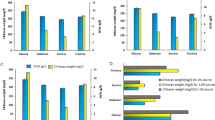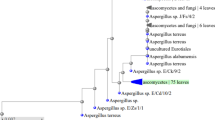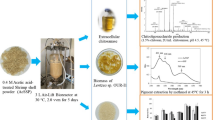Abstract
Chitosan is commonly obtained from shrimp and crab shell chitin by deacetylation; however, such supplies appear limitation. An alternative source of chitosan is cell wall in certain fungi. In this study, chitosan production through submerged fermentation of Aspergillus terreus on apple waste extract as sole carbon source was investigated. Monod equation with a maximum specific growth rate of 0.083 h−1 and half-saturation constant of 6.67 w/v% was best described the kinetic of growth. Results of response surface methodology showed the highest chitosan to substrate yield of 49.32 mg gsubstrate−1, chitosan to fungal biomass yield of 140.9 mg gcell−1, and fungal biomass to substrate yield of 0.387 gcell gsubstrate−1 were simultaneously obtained at temperature 30.0 °C, initial pH 5.98, and ammonium nitrate concentration 5.0 g L−1. The chitosan produced at the optimum condition was characterized by FTIR, TGA, and DSC analysis, and degree of deacetylation was 88.2%.
Graphic abstract












Similar content being viewed by others
References
Maghsoodi V, Yaghmaei S (2010) Comparison of solid substrate and submerged fermentation for chitosan production by Aspergillus niger. Chem Chem Eng 17:153–157
Kanatt SR, Chander R, Sharma A (2008) Chitosan and mint mixture: a new preservative for meat and meat products. Food Chem 107:845–852
Sagoo S, Board R, Roller S (2002) Chitosan inhibits growth of spoilage micro-organisms in chilled pork products. Food Microbiol 19:175–182
Khwaldia K, Arab-Tehrany E, Desobry S (2010) Biopolymer coatings on paper packaging materials. Compr Rev Food Sci Food Saf 9:82–91
Dutta PK, Duta J, Tripathi VS (2004) Chitin and chitosan: chemistry, properties and applications. J Sci Ind Res 63:20–31
Logesh A, Thillaimaharani K, Sharmila K, Kalaiselvam M, Raffi S (2012) Production of chitosan from endolichenic fungi isolated from mangrove environment and its antagonistic activity. Asian Pac J Trop Biomed 2:140–143
Ghormade V, Pathan EK, Deshpande MV (2017) Can fungi compete with marine sources for chitosan production? Int J Biol Macromol 104:1415–1421
Crini G, Badot PM (2008) Application of chitosan, a natural aminopolysaccharide, for dye removal from aqueous solutions by adsorption processes using batch studies: a review of recent literature. Prog Polym Sci 33:399–447
Schleuter D, Günther A, Paasch S, Ehrlich H, Kljajić Z, Hanke T, Bernhard G, Brunner E (2013) Chitin-based renewable materials from marine sponges for uranium adsorption. Carbohydr Polym 92:712–718
Pochanavanich P, Suntornsuk W (2002) Fungal chitosan production and its characterization. Lett Appl Microbiol 35:17–21
Nwe N, Stevens WF (2002) Production of fungal chitosan by solid substrate fermentation followed by enzymatic extraction. Biotechnol Lett 24:131–134
Hu KJ, Yeung KW, Ho KP, Hu JL (1999) Rapid extraction of high-quality chitosan from mycelia of Absidia glauca. J Food Biochem 23:187–196
Miyoshi H, Shimura K, Watanabe K, Onodera K (1992) Characterization of some fungal chitosans. Biosci Biotechnol Biochem 56:1901–1905
Kheng PP, Omar IC (2005) Xylanase production by a local fungal isolate, Aspergillus niger USM AI 1 via solid state fermentation using palm kernel cake (PKC) as substrate. Songklanakarin J Sci Technol 27:325–336
Maghsoodi V (2008) Influence of different nitrogen sources on amount of chitosan production by Aspergillus niger in solid state fermentation. Iran J Chem Chem Eng 27:47–52
White SA, Farina PR, Fulton I (1979) Production and isolation of chitosan from Mucor rouxii. Appl Environ Microbiol 38:323–328
Streit F, Koch F, Laranjeira MCM, Ninow JL (2009) Production of fungal chitosan in liquid cultivation using apple pomace as substrate. Braz J Microbiol 40:20–25
Crestini C, Kovac B, Giovannozzi-Sermanni G (1996) Production and isolation of chitosan by submerged and solid-state fermentation from Lentinus edodes. Biotechnol Bioeng 50:207–210
Tan SC, Tan TK, Wong SM, Khor E (1996) The chitosan yield of zygomycetes at their optimum harvesting time. Carbohydr Polym 30:239–242
Dhillon GS, Kaur S, Brar SK, Verma M (2012) Green synthesis approach: extraction of chitosan from fungus mycelia. Crit Rev Biotechnol 33:379–403. https://doi.org/10.3109/07388551.2012.717217
Suntornsuk W, Pochanavanich P, Suntornsuk L (2002) Fungal chitosan production on food processing by-products. Process Biochem 37:727–729
Wang W, Du Y, Qiu Y, Wang X, Hu Y, Yang J, Cai J, Kennedy JF (2008) A new green technology for direct production of low molecular weight chitosan. Carbohydr Polym 74:127–132
Kleekayai T, Suntornsuk W (2011) Production and characterization of chitosan obtained from Rhizopus oryzae grown on potato chip processing waste. World J Microbiol Biotechnol 27:1145–1154
Montgomery DC, Runger GC, Hubele NF (2001) Engineering statistics, 3rd edn. Wiley, Hoboken
Cardoso A, Lins CIM, dos Santos ER, Silva MCF, Campos-Takaki GM (2012) Microbial enhance of chitosan production by Rhizopus arrhizus using agroindustrial substrates. Molecules 17:4904–4914
Kumirska J, Czerwicka M, Kaczyński Z, Bychowska A, Brzozowski K, Thöming J, Stepnowski P (2010) Application of spectroscopic methods for structural analysis of chitin and chitosan. Mar Drugs 8:1567–1636
Alipour S, Habibi A, Taavoni S, Varmira K (2017) β-carotene production from soap stock by loofa-immobilized Rhodotorula rubra in an airlift photobioreactor. Process Biochem 54:9–19
Méndez A, Pérez C, Montañéz JC, Martínez G, Aguilar CN (2011) Red pigment production by Penicillium purpurogenum GH2 is influenced by pH and temperature. J Zhejiang Univ-Sci B (Biomed & Biotechnol) 12:961–968
Gomaa EZ (2012) Chitinase production by Bacillus thuringiensis and Bacillus licheniformis: Their potential in antifungal biocontrol. J Microbiol 50:103–111
Kannan M, Nesakumari M, Rajarathinam K, Ranjit Singh AJA (2010) Production and characterization of mushroom chitosan under solid-state fermentation conditions. Adv Biol Res 4:10–13
George TS, Senthil Guru KS, Vasanthi NS, Kannan KP (2011) Extraction, purification and characterization of chitosan from endophytic fungi isolated from medicinal plants. World J Sci Technol 1:43–48
Wang T, Li H, Wang M, Tan T (2007) Integrative extraction of ergosterol, (1→3)-α-d-glucan and chitosan from Penicillium chrysogenum mycelia. Chin J Chem Eng 15:725–729
Zvezdova D (2010) Synthesis and characterization of chitosan from marine sources in Black Sea. Annu Proc 49:65–69
Brugnerotto J, Lizardi J, Goycoolea FM, Argüelles-Monal W, Desbrières J, Rinaudo M (2001) An infrared investigation in relation with chitin and chitosan characterization. Polymer 42:3569–3580
Rumengan IFM, Suryanto E, Modaso R, Wullur S, Tallei TE, Limbong D (2014) Structural characteristics of chitin and chitosan isolated from the biomass of cultivated rotifer, Brachionus rotundiformis. Int J Fish Aquat Sci 3:12–18
Abdou ES, Nagy KSA, Elsabee MZ (2008) Extraction and characterization of chitin and chitosan from local sources. Bioresour Technol 99:1359–1367
Rao V, Johns J (2008) Thermal behavior of chitosan/natural rubber latex blends TG and DSC analysis. J Therm Anal Calorim 92(3):801–806
Kumar S, Koh J (2012) Physiochemical, optical and biological activity of chitosan-chromone derivative for biomedical applications. Int J Mol Sci 13:6102–6116
Wang Y, Chang Y, Yu L, Zhang C, Xu X, Xue Y, Li Z, Xue C (2013) Crystalline structure and thermal property characterization of chitin from Antarctic krill (Euphausia superba). Carbohydr Polym 92:90–97
Author information
Authors and Affiliations
Corresponding author
Ethics declarations
Conflict of interest
We declare that we have no conflict of interest.
Additional information
Publisher's Note
Springer Nature remains neutral with regard to jurisdictional claims in published maps and institutional affiliations.
Rights and permissions
About this article
Cite this article
Habibi, A., Karami, S., Varmira, K. et al. Key parameters optimization of chitosan production from Aspergillus terreus using apple waste extract as sole carbon source. Bioprocess Biosyst Eng 44, 283–295 (2021). https://doi.org/10.1007/s00449-020-02441-2
Received:
Accepted:
Published:
Issue Date:
DOI: https://doi.org/10.1007/s00449-020-02441-2




